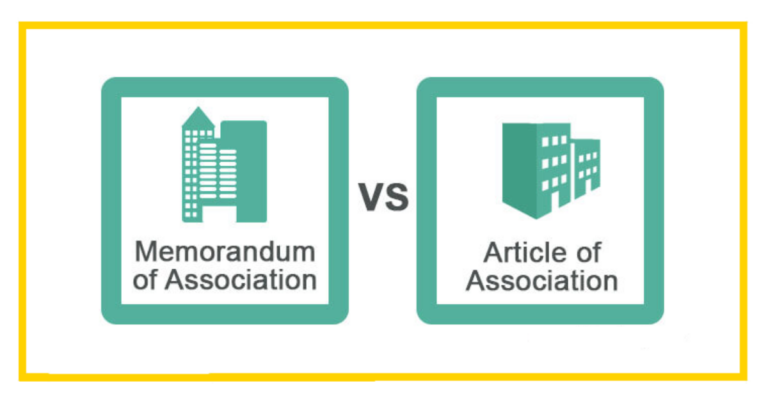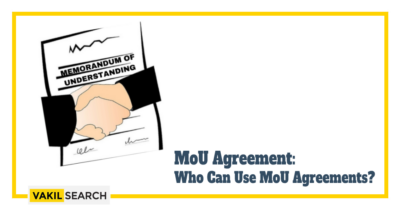The informative article covers all the aspects of MoU that everyone should know including, the full form of MoU, its elements, advantages, and disadvantage.
Overview of MOU
Before making any deal, it is really important to get familiar with the norms and the demands of the opposite party. These demands and understandings are made clear by writing on a piece of paper, known as an Agreement. This way either of the parties cannot disagree on the terms after signing the contract. Thus, it is legal proof that presents all the necessary facts about the agreement between both sides. One such document type that depicts a clear willingness to proceed with a contract is MoU. MOU Full form is a Memorandum of understanding. It presents that both parties are ready to negotiate and will consider each other’s benefits and requirements during the contract.
To validate a document as an MOU one must fulfill specific requirements to make it enforceable in court. Mentioning of date, clarity about finance, etc. are some provisions that an MoU must meet.
What is a MoU?
A memorandum of understanding (MOU) is a non-binding agreement or document that outlines the understanding and intentions of two or more parties to collaborate on a specific project or achieve a common goal. It serves as a preliminary step before drafting a formal and legally binding contract or agreement.
An MOU typically includes key terms and conditions agreed upon by the parties involved, such as the purpose and objectives of the collaboration, the roles and responsibilities of each party, the scope of the project, the timeline or duration of the agreement, any financial arrangements or contributions, and the process for resolving disputes or terminating the agreement.
While an MOU is not legally enforceable, it establishes a framework for cooperation and provides a basis for further negotiations and the development of a formal contract. It serves as a tool for clarifying the intentions and expectations of the parties involved, promoting transparency, and ensuring a mutual understanding of the collaboration.
How Does an MOU work?
An MOU specifies that soon an agreement can happen between the concerned parties. Thus, it is an expression that both the participants of the agreement are familiar with each other’s demands and are ready to respect each other’s requirements from the deal.
Though, no legal force can be used using the same as it is just an announcement of procedure towards a successful agreement.
They can be commonly found in international relationships since they can be released privately and do not take much time and effort to write.
MOUs are usually very helpful during the housing and property-related agreements. Although it is not legally enforceable, still it states and clarifies the needs and requirements of both the land owner and the buyer regarding the requirements, norms, and other demands of each other. Hence, no hidden fees, facilities or bribes, etc. can be asked apart from the agreement.
Being simpler and more flexible than contracts, MOUs are highly preferred by officials as a medium of legal documentation. Maybe it is not enforceable but still maintains trust and ensures the interest of both parties.
They can be used to align a similar goal between the parties and then work together on them to achieve the desired target that overlaps between the participants. This is also one of the reasons why MOUs are considered a sign of creative analytical thinking.
When to Use an MOU?
There can be various circumstances where you would need to have an MOU. It’s simply written with all details and demands mentioned. Due to this, many businesses, political, or government agencies opt for MOU as legal documentation as proof of their corresponding will.
An MOU can be easily used by a businessman who is looking to partner with a fellow business or a supporter who can supply the company with the right commodities. In this case, they can decide how much, for what time, and at what rate the supplier will offer the assets. And an MoU Online can be signed between both parties mentioning their wants from this deal.
Similarly, when governments of two states work together on a single project, they use such signed agreements to maintain a clear conclusion of the project. Apart from domestic settlement, they are often used in international treaties between two or multiple countries.
Before declaring such documents legal, they are examined by the United Nations Treaty collection to justify their genuineness and whether it yields a positive result or not.
An MoU does not have any authorized deadline or validation. Until and less all the mentioned goals and interests of the parties are not met, the legal documentation remains valid. Also if an MoU is legally binding then all the participants have equal rights to knock on the doors of the court, in case of violation of the MoU.
Advantages of MOU
-
-
Lucid Goals
-
Many often, the terms related to an agreement are not clear which may lead to conflict, later. Thus, it is quite important to be clear about the intentions and objectives without signing any legal document. An MoU provides a platform where agreement participants can acknowledge each other’s stipulations.
-
-
Blueprint for a Contract
-
An MoU also serves as a blueprint for a contract. Before signing a legal contract, using an MoU can be an ideal choice. It contains all the prominent information that would be there on the contract and thus, those data can be altered before getting printed on formal documents.
-
-
Eliminates Uncertainty
-
Initially, terms and conditions can be difficult for either party to understand. Thus, clearing all the confusion in the recent phase is a necessary step. By using an MoU, all the terms related to the agreement get exposed and every participant can have a glance at the objective, period, investments, partners, etc. of the contract.
This way the chance of partners exiting the deal cuts off which ultimately eliminates the uncertainty of the contract.
-
-
Ease to Exit
-
Exiting a legal contract can be typical at times while exiting an MoU is quite simple. No monetary fine or legal formalities have to be performed to leave an MoU. A party can easily do the same if they are not agreed with the terms of the MoU.
Disadvantages of MoU
-
-
Not Enforceable
-
As MoUs are not binding agreements, these documents hold no right to raise a dispute in civil court and are not enforceable. In MOA (Memorandum of Agreement) any party associated with it can challenge in court and hence, serious action can be taken against any party who violates the conditions of the agreement. On the other hand, MoU does not have any such authority.
-
-
Unclear Terms
-
Many often, a lawyer can add instructions or disclaimers about the legal bindingness of an MoU. Many times it is stated whether the document can be used for taking legal actions or not. Thus, an MoU can be legally binding or not. It becomes a compulsory step to thoroughly review the document and then only proceed to sign an agreement.
-
-
Time to Negotiate
-
As already mentioned, the degree of formalness of MOU is not much greater which allows space to negotiate the terms for both parties. Consequently, this adds to the time taken for a contract to finalize and in many cases, the deal does not succeed due to the disagreement of the parties.
What a Good MOU Should Have?
-
Proper Contact Information
Email, contact number, full name, etc. are some data that should be mentioned on the initial pages of the document. This facilitates the process of contacting any official.
-
Mentioned Conditions
The conditions of the agreement should be mentioned without any use of complex vocabulary to avoid any confusion or dispute in the future.
-
Signatures are a Must
Signatures of all the concerned personalities are a must in the documents. It does not only prove the genuineness but also represents that the signatory was present and aware of the terms and conditions.
When should you draw up an MOU?
An MOU can be drawn up in various situations when parties wish to establish a preliminary understanding or framework for collaboration. Here are some common scenarios in which you might consider creating an MOU:
- Partnership or Joint Venture: When two or more organisations or entities are considering working together on a specific project or venture, they may use an MOU to outline their shared objectives, responsibilities, and expectations before proceeding with more detailed negotiations or drafting a formal agreement.
- Research or Academic Collaboration: Universities, research institutions, or academic departments often use MOUs to define the terms of collaboration in areas such as joint research projects, exchange programs, faculty or student exchanges, or the sharing of resources and expertise.
- Business Agreements: In business contexts, an MOU can be used to outline the preliminary terms and conditions of a potential partnership, strategic alliance, or commercial transaction. It allows the parties involved to establish a common understanding before investing significant time and resources in more detailed negotiations.
- Government or Intergovernmental Cooperation: Governments or international organisations may use MOUs to facilitate cooperation on matters of mutual interest, such as economic development, cultural exchange, environmental protection, or defense collaboration. These agreements can help establish a framework for coordination and future negotiations.
- Nonprofit or NGO Collaborations: Nonprofit organisations or non-governmental organisations (NGOs) may utilise MOUs to formalise their partnerships or collaborations, particularly when working together on projects, initiatives, or advocacy efforts.
A note about MOUs in government agencies and international relations.
MOUs play a significant role in government agencies and international relations. Here are some important aspects to consider when it comes to MOUs in these contexts:
- Government Agencies: MOUs are commonly used by government agencies to establish collaborations and formalize agreements between different departments or agencies at the local, regional, or national levels. These MOUs help facilitate interagency cooperation, coordination, and resource-sharing. They can be utilized for various purposes, such as joint projects, information sharing, policy development, or the exchange of expertise.
- International Relations: MOUs are instrumental in fostering cooperation between governments and international organizations. They provide a framework for diplomatic engagements, mutual understanding, and coordination on matters of shared interest. MOUs in international relations can cover a wide range of areas, including trade and commerce, defense and security, environmental conservation, cultural exchanges, scientific research, and humanitarian efforts.
- Bilateral and Multilateral MOUs: Governments often engage in bilateral or multilateral MOUs, depending on the number of parties involved. Bilateral MOUs are agreements between two governments, while multilateral MOUs involve more than two parties. These MOUs help establish a common understanding, enhance collaboration, and address shared challenges among nations.
- Peace Treaties and Conflict Resolution: In the realm of international relations, MOUs are sometimes utilized as a precursor to formal peace treaties or as part of conflict resolution efforts. They can be employed to build trust, outline initial terms of cooperation, or lay the groundwork for negotiations toward more comprehensive agreements.
- Legal Status and Implementation: While MOUs are generally non-binding, their legal status can vary depending on the context and the intention of the parties involved. Some MOUs may explicitly state that they are legally binding, while others are intended to be more flexible and serve as guiding principles for future negotiations. The implementation of an MOU often relies on the goodwill and commitment of the parties involved.
Benefits and drawbacks of MOUs.
| Benefits of MOUs | Drawbacks of MOUs |
| 1. Flexibility | 1. Non-binding Nature |
| 2. Collaboration Framework | 2. Lack of Enforceability |
| 3. Early Agreement | 3. Potential Ambiguity |
| 4. Cost-Effective | 4. Limited Legal Protection |
| 5. Relationship Building | 5. Risk of Non-Completion |
What to include in your MOU.
When drafting an MOU (Memorandum of Understanding), the following elements should typically be included:
- Title and Introduction: Clearly state that the document is an MOU and provide a concise title that reflects the purpose or subject of the agreement. Include the names and contact information of the parties involved.
- Background and Objectives: Provide a brief overview of the background, context, and rationale for entering into the MOU. Clearly outline the shared objectives and goals that the parties aim to achieve through their collaboration.
- Scope of Collaboration: Define the scope and nature of the collaboration. Specify the areas of cooperation, projects, activities, or tasks covered by the MOU. Be clear about what is included and what is excluded from the agreement.
- Roles and Responsibilities: Clearly define the roles, responsibilities, and obligations of each party involved in the collaboration. Specify the contributions, resources, or expertise that each party will provide. It is important to ensure that responsibilities are well-defined to avoid misunderstandings or conflicts in the future.
- Timeline and Duration: Specify the duration of the MOU and any relevant timelines or milestones for the collaboration. Include the start date and end date of the agreement or outline the conditions under which the MOU may be terminated.
- Financial Considerations: If there are any financial arrangements or contributions involved in the collaboration, outline them clearly. Specify how costs will be shared, any funding sources, or any reimbursement mechanisms that apply.
- Governance and Decision-Making: Outline the governance structure or decision-making process for the collaboration. Specify how decisions will be made, who will have authority, and how potential disputes or disagreements will be resolved.
- Confidentiality and Intellectual Property: Include provisions on the protection of confidential information and intellectual property rights. Clarify how sensitive information will be handled and any restrictions on its use or disclosure.
- Communication and Reporting: Define the communication channels and frequency of reporting between the parties. Specify the mechanisms for sharing progress updates, exchanging information, and coordinating activities.
- Review and Amendment: Include a provision for the periodic review and potential amendment of the MOU. This allows the parties to reassess and modify the agreement if needed, ensuring its continued relevance and effectiveness.
- Signatures and Execution: Provide space for the authorized representatives of each party to sign and date the MOU, indicating their agreement to its terms. This demonstrates the commitment of the parties to the collaboration.
The legality of MOUs.
For an MOU to be legally binding in India, the following elements must be present:
- Offer and Acceptance: The MOU should contain a clear offer made by one party and an unequivocal acceptance of that offer by the other party. Both parties must demonstrate their mutual consent to be bound by the terms of the MOU.
- Consideration: Consideration refers to something of value exchanged between the parties as part of the agreement. While monetary consideration is not always necessary, there must be some form of mutual benefit or exchange of promises between the parties.
- Intention to Create Legal Relations: The parties must demonstrate a genuine intention to create legal relations. If the MOU explicitly states that the parties intend to be bound by the terms, it strengthens the argument for its enforceability.
- Certainty and Clarity: The terms and obligations stated in the MOU should be clear, specific, and unambiguous. Vague or uncertain terms may undermine the enforceability of the agreement.
- Capacity and Legality: The parties entering into the MOU meaning must have the legal capacity to do so, meaning they must be of legal age and have the legal authority to bind the respective entities they represent. The MOU must also comply with the laws and regulations of India.
Key Takeaways
- Legally Binding: MOUs in India can be legally binding if they fulfill the essential elements of a valid contract under the Indian Contract Act, 1872.
- Elements of a Valid Contract: For an MOU to be enforceable, it must involve offer and acceptance, consideration, intention to create legal relations, certainty and clarity of terms, and compliance with capacity and legality requirements.
- Enforceability Challenges: Disputes may arise regarding the interpretation or fulfillment of the terms in an MOU. Legal proceedings or alternative dispute resolution methods, such as mediation or arbitration, may be necessary to resolve such disputes.
- Seeking Legal Advice: It is advisable to consult with legal professionals experienced in Indian contract law to ensure the enforceability and legal validity of an MOU in India. They can provide guidance on tailoring the MOU to meet specific requirements and circumstances.
- Context Matters: The enforceability of an MOU may depend on the specific facts and circumstances of each case. Understanding the particular context and seeking legal advice can help parties navigate the legal implications of an MOU in India.
What Is the Difference Between an MOU and MOA?
It’s important to note that the specific usage and implications of MOUs and MOAs can vary depending on the jurisdiction and the intentions of the parties involved.
| MOU (Memorandum of Understanding) | MOA (Memorandum of Agreement) |
| Generally non-binding, expressing intentions and understanding between parties. | Legally binding, creating a formal agreement between parties. |
| Serves as a preliminary step before a formal contract is drafted. | Represents a more formal and final stage of agreement. |
| Focuses on collaboration, cooperation, or coordination between parties. | Establishes specific terms, conditions, and obligations to be fulfilled. |
| Often used to outline objectives, responsibilities, and general areas of cooperation. | Contains specific provisions, rights, and obligations that parties must adhere to. |
| Provides a framework for further negotiations and the development of a formal contract. | Forms a legally enforceable contract and typically includes provisions for dispute resolution. |
| Can be more flexible and allows parties to negotiate and modify terms before finalising a formal agreement. | Imposes legal obligations on the parties, providing greater certainty and enforcement mechanisms. |
| May be used in various contexts, such as partnerships, research collaborations, or government cooperation. | Often employed in business transactions, joint ventures, or complex legal arrangements. |
How Do You Write an MOU?
- Title and Introduction: Begin with a clear and concise title indicating that the document is an MOU. Include the names and contact information of the parties involved. Provide a brief introduction stating the purpose and background of the collaboration.
- Objectives: Clearly outline the shared objectives and goals of the collaboration. Describe what the parties aim to achieve through their cooperation and specify the desired outcomes.
- Scope of Collaboration: Define the scope and nature of the collaboration. Clearly state the areas of cooperation, projects, activities, or tasks covered by the MOU. Include any specific limitations or exclusions.
- Roles and Responsibilities: Define the roles, responsibilities, and obligations of each party involved. Specify the contributions, resources, or expertise that each party will provide. Ensure that the responsibilities are clearly defined to avoid misunderstandings or conflicts.
- Timeline and Duration: Specify the duration of the MOU and any relevant timelines or milestones for the collaboration. Include the start date and end date of the agreement or outline the conditions under which the MOU meaning may be terminated.
- Financial Considerations: If there are any financial arrangements or contributions involved, outline them clearly. Specify how costs will be shared, any funding sources, or any reimbursement mechanisms that apply.
- Governance and Decision-Making: Define the governance structure or decision-making process for the collaboration. Specify how decisions will be made, who will have authority, and how potential disputes or disagreements will be resolved.
- Confidentiality and Intellectual Property: Include provisions on the protection of confidential information and intellectual property rights. Clarify how sensitive information will be handled and any restrictions on its use or disclosure.
- Communication and Reporting: Define the communication channels and frequency of reporting between the parties. Specify the mechanisms for sharing progress updates, exchanging information, and coordinating activities.
- Review and Amendment: Include a provision for the periodic review and potential amendment of the MOU. This allows the parties to reassess and modify the agreement if needed, ensuring its continued relevance and effectiveness.
- Signatures and Execution: Provide space for the authorised representatives of each party to sign and date the MOU, indicating their agreement to its terms. This demonstrates the commitment of the parties to the collaboration.
|
[Your Organisation’s Name] [Address] [City, State, ZIP Code] [Country] [Date] MEMORANDUM OF UNDERSTANDING Between [Party A] [Address] [City, State, ZIP Code] [Country] and [Party B] [Address] [City, State, ZIP Code] [Country] 1. Title and Introduction This Memorandum of Understanding (MOU) is entered into between [Party A] and [Party B] (collectively referred to as the “Parties”) on this [date] for the purpose of establishing a collaborative relationship. 2. Objectives The Parties agree to collaborate in [specify the objectives and goals of the collaboration]. The primary objective of this collaboration is to [describe the desired outcomes or benefits]. 3. Scope of Collaboration The Parties will collaborate in the following areas: – [Specify area of cooperation] – [Specify area of cooperation] – [Specify area of cooperation] 4. Roles and Responsibilities 4.1 [Party A] Responsibilities: – [Describe the responsibilities, contributions, or resources that [Party A] will provide] 4.2 [Party B] Responsibilities: – [Describe the responsibilities, contributions, or resources that [Party B] will provide] 5. Timeline and Duration This MOU meaning will be effective as of the date first written above and will remain in effect for a period of [specify duration] unless terminated earlier by mutual written agreement or in accordance with the termination provisions outlined in Section [X]. 6. Financial Considerations The Parties agree to share the costs and expenses associated with the collaboration as follows: – [Specify the financial arrangements, funding sources, or reimbursement mechanisms, if applicable] 7. Governance and Decision-Making – [Describe the governance structure or decision-making process, including how decisions will be made and who will have authority] 8. Confidentiality and Intellectual Property – [Include provisions on the protection of confidential information and intellectual property rights, specifying how sensitive information will be handled and any restrictions on its use or disclosure] 9. Communication and Reporting – [Outline the communication channels and frequency of reporting, specifying how progress updates, information sharing, and coordination activities will take place] 10. Review and Amendment This MOU may be subject to periodic review and can be amended or modified by mutual written agreement of the Parties. 11. Signatures and Execution This MOU is executed in duplicate, with each Party retaining one original copy. [Party A] Name: Title: Date: [Party B] Name: Title: Date: |
Conclusion
Formulating a Memorandum of Understanding is not a cakewalk. There are many critical terms and steps to perform that should be taken only under the surveillance of a professional and experienced lawyer.
Vakilsearch is the one-stop solution for all your legal needs. This platform, alone, has Lawyers, chartered accountants, and Company Secretaries that can help you while writing any legal documents. On the other hand, their quick support is another reason why many people choose it.
Their services are reliable and affordable that can be easily availed on their mobile application or website.
FAQs
Is MOU a legal document?
Yes, a Memorandum of Understanding (MOU) is a legal document that outlines the terms and intentions of an agreement between parties.
What does MOU stand for in business?
MOU stands for Memorandum of Understanding, which is a written agreement between parties outlining the terms and conditions of their understanding.
What is the difference between an MOU and an agreement?
An MOU is often less formal than a contract or agreement and may outline the parties' intentions to work together without creating binding legal obligations. An agreement, on the other hand, typically creates legal obligations and is more detailed and formal.
How long is an MOU valid?
The Memorandum of Understanding (MOU) will take effect upon signing and will be valid for three years. It will automatically renew for additional three-year terms unless either party provides written notice of termination at least six months prior to the expiration date.
Can an MOU be cancelled?
Yes, an MOU can be cancelled or terminated by mutual agreement of the parties involved or by one party if certain conditions outlined in the MOU are not met.
What comes before MOU?
Before an MOU, parties may engage in discussions, negotiations, or preliminary agreements to outline their intentions and reach a consensus on key terms.
What is another name for a MOU?
Another name for an MOU is a Letter of Intent (LOI), although they may have slight differences in format and purpose depending on the context.
Are MOU and LOI the same?
MOU and LOI are similar in that they both outline the parties' intentions and terms of agreement, but they may differ in format and specific legal implications depending on the context.
Is MOU a formal document?
While MOUs are generally less formal than contracts, they are still considered formal documents that can be legally binding if they meet certain criteria, such as clear and mutual agreement between the parties.
What is the difference between MOA and MOU?
MOA stands for Memorandum of Agreement and is typically a more formal document than an MOU, outlining specific obligations and commitments of the parties involved, whereas an MOU is often more general and may not create legally binding obligations.
How do I make an MOU legal?
To make an MOU legally binding, it should clearly outline the intentions of the parties, be signed by all parties involved, and may require consideration (e.g., an exchange of something of value). It's advisable to seek legal advice when drafting an MOU to ensure its validity and enforceability.
Helpful Links










